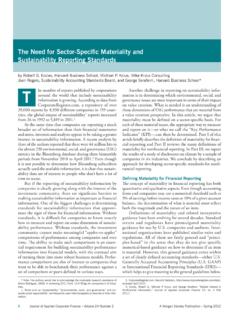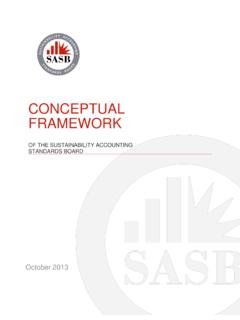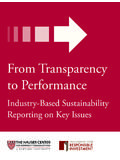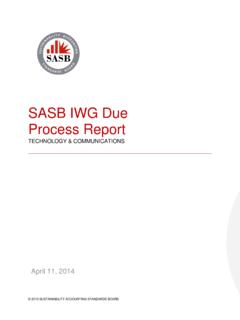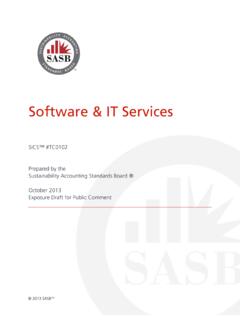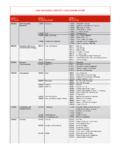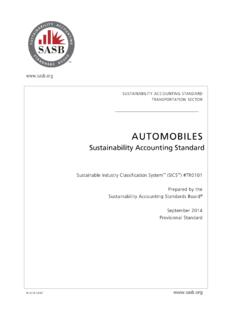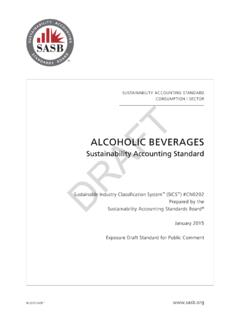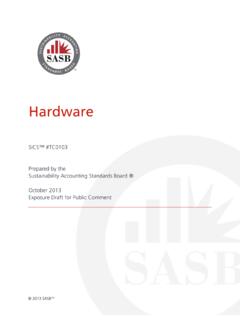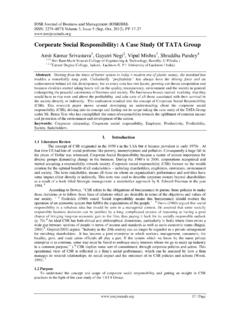Transcription of On Materiality and SuStainability
1 On Materiality and SuStainability : the value of disclosure in the Capital MarketsInitiative for Responsible InvestmentHauser Center for Nonprofit Organizations at Harvard UniversitySeptember 2012 Steve LydenbergInitiative for Responsible InvestmentHauser Center for Non-Profit Corporations Harvard University, 102 Belfer79 JFK StreetCambridge, Massachusetts Materiality and SuStainability : the value of disclosure in the Capital MarketsInitiative for Responsible InvestmentHauser Center for Nonprofit Organizations at Harvard UniversitySeptember 20123On Materiality and SustainabilityCONteNtSOn Materiality and SuStainability : the value of disclosure in the Capital MarketsContentsAcknowledgements.
2 4executive Summary ..5 Part One: Historical Background and Current Debate Concerning Corporate Disclosure and SuStainability ..10I-A. Legislation and Legal Background Concerning Corporate Disclosure ..10I-B. Legal Arguments for SuStainability Disclosure ..19I-C. Background on the Increased Importance of SuStainability ..30 Part two: Robust Definition of Corporate Data Disclosures..44II-A. existing Definitions of Robust Corporate Disclosure ..44II-B. Disclosure of SuStainability Data Defined ..49 Part three: Increasing Interest in Material SuStainability Data.
3 52 III-A. Increased Interest in SuStainability Disclosure among Institutional Investors, Stock exchanges, Corporations, and Regulators ..52 Part Four: Prioritization of Material SuStainability Indicators ..62IV-A. Need for Prioritization of Material SuStainability Indicators ..62IV-B. Current Status of Prioritization of Material SuStainability Indicators ..65IV-C. Methodology for Prioritization of Industry-Level Material SuStainability Key Performance Indicators ..71IV-D. the Benefits and Costs of Mandated Material SuStainability Key Performance Indicators.
4 78 Conclusion ..85 Bibliography ..874On Materiality and SustainabilityPReFACePrefacethe Initiative for Responsible Investment, a project of the Hauser Center for Nonprofit Corporations at Harvard University, has prepared this report On Materiality and SuStainability : the value of Disclosure in the Capital Markets for the SuStainability Accounting Standards Board (SASB). Steve Lydenberg is the report s author. this report builds on the report From Transparency to Performance: Industry-Based SuStainability Reporting on Key Issues published by the Initiative for Responsible Investment in June 2010.
5 5On Materiality and SustainabilityACKNOwLeDgeMeNtSAcknowledg ementsI would like to thank those who provided insight, feedback and advice along the way in the preparation of this report. I am grateful for background conversations and comments on drafts of this report to Bill Baue, Jim Coburn, Robert eccles, John ehrenfeld, Andrea Fernandez, Katie grace, Dan Hanson, Jim Hawley, Stefanie Hiss, Harry Hummels, Keith Johnson, Adam Kanzer, Alya Kayal, John Katovich, ernst Ligteringen, Rob Mcgarrah, Mark Mcelroy, Chris McKnett, Andrea Moffat, Andrew Park, Jean Rogers, Michael toffel, Jay Youngdahl, ed waitzer, Lisa woll, and David wood.
6 A productive conversation with Allen white provided much useful clarification about the relationship between financial and SuStainability reporting as represented in Figure One. I am especially indebted to Monika Freyman for her research on the development of the concept of SuStainability over the past century and her preparation of a background paper on this topic. In addition, I would like to express gratitude on the part of the Initiative for Responsible Investment to Ralph taylor and the Metanoia Fund whose financial support that made this paper possible, as well as to the Brooks Family Foundation for its support of the Initiative for Responsible Investment s activities.
7 6On Materiality and SustainabilityexeCUtIVe SUMMARY executive Summarywith the passage of the Securities exchange Act of 1934, Congress created the Securities and exchange Commission (SeC) and empowered it to require disclosure of corporate data material to the public interest and the protection of investors. Congress mandated this disclosure in part to assure fair and honest markets, reliable prices, and unencumbered interstate commerce. In addition, with the lessons of the 1929 stock market crash and subsequent great Depression in mind, Congress believed that SeC oversight of the financial markets could help avert, moderate, or shorten national emergencies precipitated by financial crises.
8 Since that time, the courts and the SeC have generally defined information sufficiently material to require reporting as information that would be useful to reasonable investors considering a total mix of information in their decision making. the SeC, accountants, and others have typically interpreted this mandate to include required reporting on corporate financials, but not on non-financial SuStainability data. A number of legal scholars have recently pointed out that the SeC has the ability under current law to require the disclosure of non-financial data including SuStainability or eSg (environmental, social and governance) data as it deems necessary.
9 They have also argued that the SeC has an obligation to require SuStainability disclosure if a substantial portion of the investment community considers this information material (a substantial number of institutional investors now assert eSg data is important to their investment process); if corporations are disclosing only half-truths (several thousand corporations worldwide now publish SuStainability reports, but in widely differing depth and formats); and if asymmetries in the availability of corporate data exist (a widening gap exists between institutional investors who have access to eSg data and retail investors who do not).
10 While generally arguing that systematic disclosure of SuStainability data is not appropriate, in response to specific recent crises the SeC and Congress have nevertheless mandated the disclosure of specific environmental, social, and governance data at various times. the growing interest in disclosure of SuStainability data is symptomatic of the increased recognition since the 1980s of the importance of the concept of SuStainability to the management of corporations, ecosystems, and economies in an increasingly populous, technologically sophisticated, globalized, and resource-constrained world.
